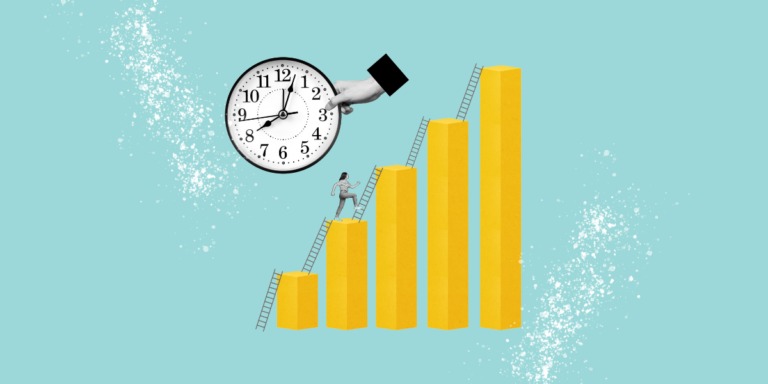The complete guide to sales cycles (+ how to shorten them)
In this blog
- What is a B2B sales cycle?
- B2B sales cycle stages
- What is the average B2B sales cycle?
- Average sales cycle formula
- Difference between short cycle and long cycle in sales
- Ways to shorten your B2B sales cycle
- Why you should also nurture long-lasting leads
- Strategies to extend the lead lifecycle
- Balancing the sales cycle and lead lifecycle

Extend the longevity of your B2B leads and shortening your sales cycle. Discover effective strategies for speeding up your sales process. Boost conversion rates and drive business growth.
In B2B sales, the journey from lead generation to closing a deal can be long and complex. Understanding how to shorten the sales cycle is crucial for sustaining a healthy pipeline and achieving sales targets. But extending the lifespan of your leads, to keep alive the leads that don’t close straight away, is equally important.
This blog will first provide actionable tips on speeding up your sales cycle. Then, we’ll explore practical strategies for nurturing long-lasting B2B leads.
First up, let’s talk about the B2B sales cycle. 👇
What is a B2B sales cycle?
Your B2B sales cycle is the actions your company takes when selling its product or service to another business. It is broken down into different stages, each one designed to help sales teams convert prospects into customers.
The B2B cycle is typically longer and more intricate than B2C (Business-to-Consumer) sales. Multiple decision-makers are now the norm, deals involve higher-value transactions, and complex processes are often in place.
B2B sales cycle stages
The average sales cycle is generally said to have seven distinct stages.
It begins with prospecting, identifying and researching potential leads.
Next, leads are qualified to determine suitability based on budget, authority, need, and timeline.
The process continues with needs analysis, where your sales reps aim to understand their specific challenges and requirements.
A tailored sales proposal is made, showcasing how your product or service can address the lead’s needs.
Finally, the cycle concludes with negotiation, agreement, and closing of the sale, followed by post-sale support to ensure customer satisfaction and foster long-term relationships.
What is the average B2B sales cycle?
B2B sales cycle length depends on a number of factors. The size of the deal often has the biggest impact, but industry, complexity of the deal, and the number of decision-makers all play a part too.
A survey from databox has shown more than 30% of deals take between one and three months.
Average sales cycle formula
To calculate how long it takes you to sign deals, take the total number of days over a chosen period and divide it by the number of deals closed in that same period.
Difference between short cycle and long cycle in sales
Unsurprisingly, the difference between a short cycle and a long cycle is the time it takes to close a deal.
A short sales cycle usually lasts from a few days to a few weeks. It’s quick and straightforward, often involving less expensive products that require fewer approvals and pose lower risks for the buyer. This approach works well for high-volume sales where speed and efficiency matter most.
On the flip side, a long sales cycle can take several months to over a year. It involves multiple stakeholders, detailed negotiations, and often more complex or high-value products.
Advantages of long vs short sales cycle
Short sales cycles have the advantage of generating revenue quickly, allowing more sales within a certain period and lowering the cost per lead due to shorter engagements. However, they often come with lower profit margins and rely heavily on volume to hit sales targets.
A longer sales cycle can lead to higher-value deals and stronger, long-term relationships with clients. It can also help you better understand customer needs and provide tailored solutions, boosting loyalty and retention. The downside is that it requires significant time and resources, comes with a higher risk of deals falling through, and can affect cash flow and revenue forecasting.
Ways to shorten your B2B sales cycle
A shorter sales cycle means faster revenue generation and better resource allocation.
Accelerate your sales process with these tips and tricks, helping move leads through sales pitches into closed won.
Qualify leads early ⏱️
Use lead scoring to identify and prioritise high-quality leads
Lead scoring is a valuable tactic to make the most of. Don’t waste your sales rep’s time focusing on unsuitable or low-value prospects!
Be sure you’re tracking and measuring engagement, recording which pages are being visited, which webinars are attended, the email open rate, and how the prospect responds to different offers. Dedicated sales platforms like HubSpot can automatically score and prioritise leads based on these specific criteria.

Lead scoring best practices
Lead scoring: why you need it and the best practices for making it work for your business.
Find out moreImplement a robust lead qualification process
Divide your leads into either sales-ready or sales-unready and good fit or poor fit.
Good-fit leads match any of your personas, and sales readiness is determined through lead scoring.
Once you have a decisive criterion for qualifying leads, you can automate the fit and sales readiness process using a lead-scoring feature.
Streamline your sales process 🔎
Map out your sales process and identify bottlenecks.
To map out your B2B sales process, document each step, from lead generation to closing the deal.
Analyse this workflow to identify stages where delays or drop-offs occur. Use CRM tools (we told you it was a great asset!) to track metrics and gather data on conversion rates and time spent at each stage.
You can then implement targeted improvements to streamline and speed up your sales cycle by pinpointing these bottlenecks.
Implement automation tools
70% of your sales reps’ time is spent on admin tasks such as appointment setting and prospecting research – both of which can now be fully automated. In fact, if you’re looking for an appointment setting agency, you’re in the right place. Sopro can help your teams save time and effort, so they can focus on having conversations with qualified buyers.
It makes business sense to use tools that help with sales enablement, engagement, chatbots, virtual assistants, and so much more. Join the 38% of sales teams that are saving time by automating these tasks!
Enhance your value proposition 🎉
Clearly communicate your unique value and benefits
Highlighting unique value propositions is crucial for differentiation in what can often be an overcrowded marketplace.
While the price and features of your product or service might not significantly set your solution apart, emphasising exceptional after-sales and customer service can create a distinct competitive edge.
In markets with poor service records, showcasing your commitment through tangible examples of going above and beyond can resonate powerfully with prospects who might be bombarded with choices.
Additionally, promoting your company’s ethos, such as a solid commitment to corporate social responsibility (CSR) or emphasising unique operational approaches, like partnering instead of outsourcing, can attract attention.
Most notably, companies who take the time to invest in a social purpose have reported generating 20% more revenue than those who don’t.
Tailor your value proposition
One way to stand out uniquely is by segmenting your value proposition, a valuable tactic when developing sales strategies.
Conduct thorough Market Research to understand each segment’s unique challenges and needs.
Develop detailed buyer personas to represent these segments. Hopefully, you’ve already done this, but just in case you need a refresher… 👇
Customise your messaging to highlight how your product or service addresses their pain points, delivers benefits, and adds value.
In addition, use case studies and testimonials from similar businesses to build credibility. This could help your message resonate further.
Continuously gather feedback from each segment to refine and adjust your value proposition, ensuring it remains relevant and compelling to your diverse audience.
Improve sales training
Provide regular training for your sales team
Regular training for your B2B sales team is crucial for improving skills and knowledge, ensuring they stay updated on industry trends, sales techniques, and product knowledge.
Don’t head straight for the sales wins without doing the necessary training first.
Effective and continual training enhances your sales rep’s ability to handle objections, understand customer needs, and close deals effectively. Training also boosts confidence, motivation, and overall performance, leading to higher conversion rates and customer satisfaction.
By investing in continuous learning, you foster a culture of growth and adaptability, enabling your team to navigate the complexities of B2B sales and maintain a competitive edge in the market.

What is sales coaching?
Elevate your sales team’s performance through effective sales coaching and training strategies
Sell moreEquip your team with the latest tools and techniques
Equipping your sales team with the latest tools and techniques is crucial for handling objections effectively and closing deals faster.
An excellent tech stack will streamline workflows and provide insights essential for sales efficiency. These tools include CRM systems, automated outreach software, and data analytics platforms, which help sales teams target the right prospects, personalise communication, and track engagement in real time.
Implementing these tools allows your team to focus more on closing deals rather than on administrative tasks, thereby speeding up your B2B sales cycle. For instance, advanced CRM integrations and live reporting dashboards ensure sales reps have up-to-date information on prospects and can respond swiftly to inquiries and objections.
Moreover, these tools enhance lead generation and market expansion efforts, allowing your team to test new markets with minimal risk and cost. By leveraging data-driven insights and automated outreach, your team can engage with the right prospects more effectively, leading to higher conversion rates and a shorter sales cycle.
Build strong relationships
Focus on building solid relationships with key decision-makers.
Did you know? There are now an average of four decision-makers involved in the buying process.
Targeting key decision-makers is crucial for shortening the B2B sales cycle because they have the authority to approve purchases, eliminating delays caused by hierarchical decision processes.
To reach these influencers, leverage data analytics to identify their roles and interests, use personalised messaging to address their pain points, and employ multi-channel outreach to ensure visibility and engagement. Integrating CRM systems and automated prospecting tools can streamline this process, ensuring that your team focuses on high-potential leads, thereby speeding up the sales cycle.
Foster trust and credibility
Fostering trust and credibility through consistent B2B communications involves regular, transparent, and personalised interactions.
Regular updates demonstrate reliability and commitment, while transparency in sharing information builds trust.
Personalised communication shows that you understand and value your client’s specific needs. Additionally, promptly addressing concerns and providing valuable insights can further establish your credibility as a trusted advisor.
Offer incentives and discounts
Provide limited-time offers, discounts, or incentives
Providing limited-time offers, discounts, or incentives creates a sense of urgency, prompting faster decision-making.
This urgency can shorten the sales cycle by encouraging prospects to act quickly to take advantage of the special terms.
To implement this strategy, clearly communicate the value and scarcity of the offer through personalised emails, follow-up calls, and targeted ads. Additionally, highlight the benefits and cost savings to make the offer more appealing. Ensuring that these offers are time-bound and prominently advertised will increase their effectiveness.
Why you should also nurture long-lasting leads
Extending the time that leads are active in your sales pipeline may sound counter to the idea of speeding up the sales process. But there will always be deals that take longer to close. If you don’t keep them alive, you risk bigger deals going cold.
Maintaining the longevity of your leads ensures that your sales funnel remains robust and active. Luckily, some of the tips and tricks we’ve already covered will serve you well here, too.
Long-term engagement with leads allows for:
- Relationship building
Long-term leads provide more opportunities to build trust and rapport with potential clients. - Understanding needs
Extended engagement allows a better grasp of the prospect’s pain points and requirements. - Higher conversion rates
Consistent nurturing can lead to higher conversion rates as trust and value are established over time.
Strategies to extend the lead lifecycle
Consistent communication 🔊
Regular follow-ups via email, calls, or social media
Ever heard of multi-channel prospecting? There’s a real benefit to consistent communication across multiple channels. With buyers happy to be contacted on an average of 2.8 channels, it’s an easy way to keep your brand top of mind.
Use personalised content to keep leads engaged
But how can you leverage the power of personalisation? By tracking buyer intent, of course! Monitoring key activities, such as whether someone has downloaded a report or interacted with your web chat, can help you deliver the right message at the right time.
Content marketing 📝
Provide valuable, informative content
It’s important to note the sales cycle here. Don’t just push content out for the sake of it—it needs to be relevant to the prospect.
You should create content that resonates at different stages of the sales cycle. Your content at the awareness stage will differ significantly from what a prospect should see in decision-making.
Use content to educate and build trust.
Producing content that highlights your expertise can help you harness authority and trust. Use a case study to show previous success, a whitepaper to present your collected data, and blogs to express knowledge or thought leadership.
Lead scoring and segmentation ✅
Segment your leads
By segmenting prospects based on their position in the sales funnel, you can focus your nurturing strategies most effectively, leading to more closed deals.
Use lead scoring
Lead scoring is a way to assign value to prospects based on their progress from expressing initial interest to revealing purchase intent.
It tracks their journey through the sales funnel and assesses their likelihood of converting to a sale.
CRM integration 🖥️
Use a CRM to track leads and manage relationships
Did you know? 91% of companies are already making the most of a CRM, and for good reason. It will go a long way in helping you keep track of your outreach, automate workflows (saving the sales team valuable time), and help with practical, timely nurturing.
Automate follow-up reminders
You should automate follow-up reminders and tasks to ensure no lead is forgotten. Companies that developed their lead nurturing strategies using automation tools converted an average of 15-20% more potential clients. What are you waiting for?
Balancing the sales cycle and lead lifecycle
Incorporating strategies that extend the lead lifecycle while accelerating the sales cycle helps build a robust B2B sales strategy.
These tactics ensure a healthy sales pipeline, foster deeper relationships with prospects, and drive business growth.
Consistent and personalised communication, supported by advanced CRM systems and automation tools, builds trust and keeps leads engaged and moving through the sales funnel efficiently.
Content marketing and lead segmentation enable targeted nurturing, ensuring prospects receive relevant information at the right time. This approach enhances conversion rates and positions your business as a trusted authority in your field.
Similarly, implementing lead scoring and early qualification processes focuses efforts on high-value leads, optimises resource allocation, and increases the likelihood of closing deals faster.
Ending on a high note: providing limited-time offers and incentives creates a sense of urgency, prompting quicker decision-making and accelerating revenue generation.
By integrating these strategies, businesses can enjoy a streamlined, efficient sales process, better resource utilisation, and sustained growth in an increasingly competitive B2B market.
If you’re looking for a standout B2B lead generation agency with the skills, experience and tenacity needed to bring your business’s ideal customers knocking on your door, get in touch and let’s get to work. Whether you need lead generation for financial companies, a lead generation agency for enterprise businesses, or a lead generation agency for management consultants, you won’t need to look any further than Sopro.
.
Or, if you need more guidance, take a look at our blog. Our experts have compiled guides on everything you need to know about lead generation on prospecting, including information on how to overcome sales objections, how to generate more leads from webinars, and lead rates by company size.







Share